Mounted Penta Prism
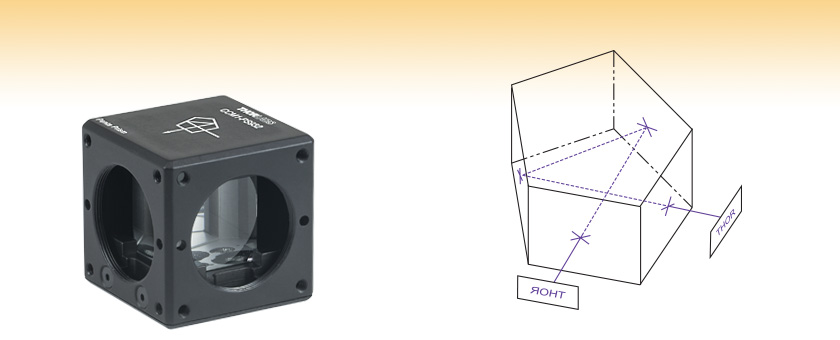
- 90° Deviation of Beam or Image without Changing Polarization Handedness
- N-BK7 Prism with Aluminum-Coated Reflective Faces
- 30 mm Cage Cube Mount with SM1-Threaded Ports
CCM1-PS932
Penta Prisms Deviate the Incident Light by 90° without Inverting or Reversing the Image

Please Wait
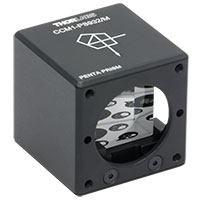
Click to Enlarge
Figure 1.1 The CCM1-PS932(/M) features two SM1-threaded ports and has two closed sides to minimize light leakage.
Features
- Deviate Beams Without Reversal or Inversion of the Beam Profile
- 90º Beam Deviation is Insensitive to Beam/Prism Alignment
- N-BK7 Prism with Aluminum-Coated Reflective Faces
- Post Mountable and 30 mm Cage System Compatible
- Compatible with SM1-Threaded (1.035"-40) Components
- Connect Two Cage Cubes Side by Side with the CM1-CC Cage Cube Connector
Penta prisms deviate incident light by 90° without inverting or reversing the image (i.e., without changing the polarization handedness). Additionally, the 90° image deviation is independent of the orientation of the prism with respect to the incident beam or image, making penta prisms an effective alternative to turning mirrors. The only limitation on alignment is the >Ø12 mm clear aperture of the housing.
Thorlabs' Mounted Penta Prism is fabricated from N-BK7 with two aluminized reflective faces protected by an Inconel and black paint overcoat. It features a clear aperture of >Ø12 mm and is mounted inside a standard 30 mm cage system cage cube. The prism is epoxied within a cage cube mount and cannot be removed. Note that the beam exits the cage cube mount at 90° ± 20 arcmin.
Cage System Compatibility
The housing provides an 8-32 (M4) tap for post mounting, SM1-threaded (1.035"-40) input and output ports, and eight 4-40-tapped holes for cage rods on the entrance and exit faces. The CCM1-PS932(/M) features two SM1-threaded ports and has two closed sides to minimize light leakage. The penta prism cage cube can be connected to other cage cubes using cage rods and ERSCB adapters or can be connected side-by-side to other cage cubes with our CM1-CC connector. The CM1-CC cage cube connector can only be used on the entrance and exit faces of these cubes.
Other Cage Cube Options
We also offer 10, 20, 40, and 60 mm unmounted penta prisms. Empty 30 mm cage cubes are available for mounting our 20 mm unmounted penta prism. For a complete selection of our cube-mounted optics please see the Mounted Optics Guide tab.
Selection Guide for Prisms
Thorlabs offers a wide variety of prisms, which can be used to reflect, invert, rotate, disperse, steer, and collimate light. For prisms and substrates not listed below, please contact Tech Support.
Beam Steering Prisms
| Prism | Material | Deviation | Invert | Reverse or Rotate | Illustration | Applications |
|---|---|---|---|---|---|---|
| Right Angle Prisms | N-BK7, UV Fused Silica, Calcium Fluoride, or Zinc Selenide | 90° | 90° | No | 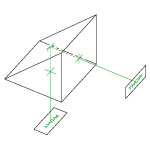 |
90° reflector used in optical systems such as telescopes and periscopes. |
| 180° | 180° | No | 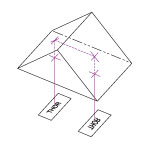 |
180° reflector, independent of entrance beam angle. Acts as a non-reversing mirror and can be used in binocular configurations. |
||
| TIR Retroreflectors (Unmounted and Mounted) and Specular Retroreflectors (Unmounted and Mounted) |
N-BK7 | 180° | 180° | No | 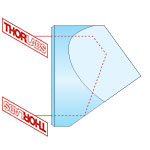 |
180° reflector, independent of entrance beam angle. Beam alignment and beam delivery. Substitute for mirror in applications where orientation is difficult to control. |
| Unmounted Penta Prisms and Mounted Penta Prisms |
N-BK7 | 90° | No | No | 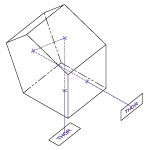 |
90° reflector, without inversion or reversal of the beam profile. Can be used for alignment and optical tooling. |
| Roof Prisms | N-BK7 | 90° | 90° | 180o Rotation | 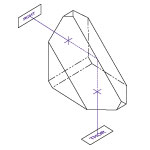 |
90° reflector, inverted and rotated (deflected left to right and top to bottom). Can be used for alignment and optical tooling. |
| Unmounted Dove Prisms and Mounted Dove Prisms |
N-BK7 | No | 180° | 2x Prism Rotation | 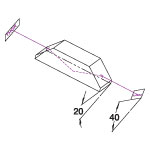 |
Dove prisms may invert, reverse, or rotate an image based on which face the light is incident on. Prism in a beam rotator orientation. |
| 180° | 180° | No | 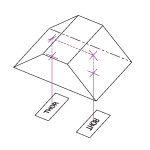 |
Prism acts as a non-reversing mirror. Same properties as a retroreflector or right angle (180° orientation) prism in an optical setup. |
||
| Wedge Prisms | N-BK7 | Models Available from 2° to 10° | No | No |  |
Beam steering applications. By rotating one wedged prism, light can be steered to trace the circle defined by 2 times the specified deviation angle. |
| No | No |  |
Variable beam steering applications. When both wedges are rotated, the beam can be moved anywhere within the circle defined by 4 times the specified deviation angle. |
|||
| Coupling Prisms | Rutile (TiO2) or GGG | Variablea | No | No | 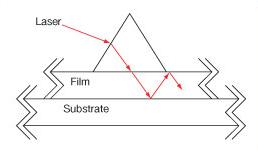 |
High index of refraction substrate used to couple light into films. Rutile used for nfilm > 1.8 GGG used for nfilm < 1.8 |
Dispersive Prisms
| Prism | Material | Deviation | Invert | Reverse or Rotate | Illustration | Applications |
|---|---|---|---|---|---|---|
| Equilateral Prisms | F2, N-F2, N-SF11, Calcium Fluoride, or Zinc Selenide |
Variablea | No | No | 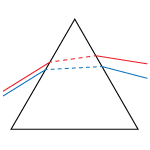 |
Dispersion prisms are a substitute for diffraction gratings. Use to separate white light into visible spectrum. |
| Dispersion Compensating Prism Pairs | Fused Silica, Calcium Fluoride, SF10, or N-SF14 | Variable Vertical Offset | No | No |  |
Compensate for pulse broadening effects in ultrafast laser systems. Can be used as an optical filter, for wavelength tuning, or dispersion compensation.
|
| Pellin Broca Prisms | N-BK7, UV Fused Silica, or Calcium Fluoride |
90° | 90° | No | 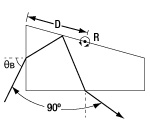 |
Ideal for wavelength separation of a beam of light, output at 90°. Used to separate harmonics of a laser or compensate for group velocity dispersion. |
Beam Manipulating Prisms
| Prism | Material | Deviation | Invert | Reverse or Rotate | Illustration | Applications |
|---|---|---|---|---|---|---|
| Anamorphic Prism Pairs | N-KZFS8 or N-SF11 |
Variable Vertical Offset | No | No | 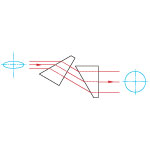 |
Variable magnification along one axis. Collimating elliptical beams (e.g., laser diodes) Converts an elliptical beam into a circular beam by magnifying or contracting the input beam in one axis. |
| Axicons (UVFS, ZnSe) | UV Fused Silica or Zinc Selenide |
Variablea | No | No |
Creates a conical, non-diverging beam with a Bessel intensity profile from a collimated source. |
Polarization Altering Prisms
| Prism | Material | Deviation | Invert | Reverse or Rotate | Illustration | Applications |
|---|---|---|---|---|---|---|
| Glan-Taylor, Glan-Laser, and α-BBO Glan-Laser Polarizers | Glan-Taylor: Calcite Glan-Laser: α-BBO or Calcite |
p-pol. - 0° s-pol. - 112°a |
No | No | 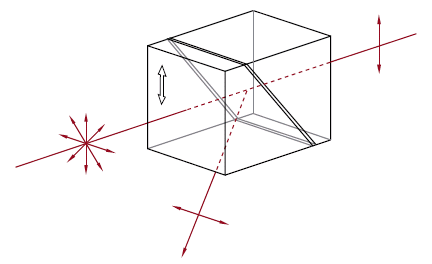 |
Double prism configuration and birefringent calcite produce extremely pure linearly polarized light. Total Internal Reflection of s-pol. at the gap between the prism while p-pol. is transmitted. |
| Rutile Polarizers | Rutile (TiO2) | s-pol. - 0° p-pol. absorbed by housing |
No | No | 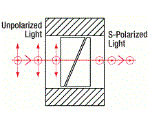 |
Double prism configuration and birefringent rutile (TiO2) produce extremely pure linearly polarized light. Total Internal Reflection of p-pol. at the gap between the prisms while s-pol. is transmitted.
|
| Double Glan-Taylor Polarizers | Calcite | p-pol. - 0° s-pol. absorbed by housing |
No | No | 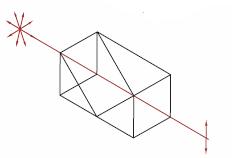 |
Triple prism configuration and birefringent calcite produce maximum polarized field over a large half angle. Total Internal Reflection of s-pol. at the gap between the prism while p-pol. is transmitted. |
| Glan Thompson Polarizers | Calcite | p-pol. - 0° s-pol. absorbed by housing |
No | No |  |
Double prism configuration and birefringent calcite produce a polarizer with the widest field of view while maintaining a high extinction ratio. Total Internal Reflection of s-pol. at the gap between the prism while p-pol. is transmitted. |
| Wollaston Prisms and Wollaston Polarizers |
Quartz, Magnesium Fluoride, α-BBO, Calcite, Yttrium Orthovanadate | Symmetric p-pol. and s-pol. deviation angle |
No | No | 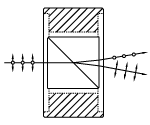 |
Double prism configuration and birefringent calcite produce the widest deviation angle of beam displacing polarizers. s-pol. and p-pol. deviate symmetrically from the prism. Wollaston prisms are used in spectrometers and polarization analyzers. |
| Rochon Prisms | Magnesium Fluoride or Yttrium Orthovanadate |
Ordinary Ray: 0° Extraordinary Ray: deviation angle |
No | No |  |
Double prism configuration and birefringent MgF2 or YVO4 produce a small deviation angle with a high extinction ratio. Extraordinary ray deviates from the input beam's optical axis, while ordinary ray does not deviate. |
| Beam Displacing Prisms | Calcite | 2.7 or 4.0 mm Beam Displacement | No | No | 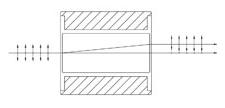 |
Single prism configuration and birefringent calcite separate an input beam into two orthogonally polarized output beams. s-pol. and p-pol. are displaced by 2.7 or 4.0 mm. Beam displacing prisms can be used as polarizing beamsplitters where 90o separation is not possible. |
| Fresnel Rhomb Retarders | N-BK7 | Linear to circular polarization Vertical Offset |
No | No | 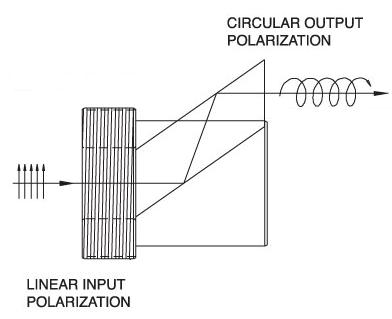 |
λ/4 Fresnel Rhomb Retarder turns a linear input into circularly polarized output. Uniform λ/4 retardance over a wider wavelength range compared to birefringent wave plates. |
| Rotates linearly polarized light 90° | No | No |  |
λ/2 Fresnel Rhomb Retarder rotates linearly polarized light 90°. Uniform λ/2 retardance over a wider wavelength range compared to birefringent wave plates. |
Beamsplitter Prisms
| Prism | Material | Deviation | Invert | Reverse or Rotate | Illustration | Applications |
|---|---|---|---|---|---|---|
| Beamsplitter Cubes | N-BK7 | 50:50 splitting ratio, 0° and 90° s- and p- pol. within 10% of each other |
No | No | 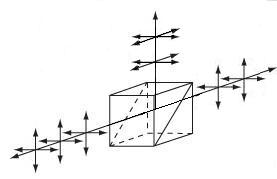 |
Double prism configuration and dielectric coating provide 50:50 beamsplitting nearly independent of polarization. Non-polarizing beamsplitter over the specified wavelength range. |
| Polarizing Beamsplitter Cubes | N-BK7, UV Fused Silica, or N-SF1 | p-pol. - 0° s-pol. - 90° |
No | No | 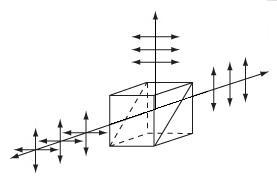 |
Double prism configuration and dielectric coating transmit p-pol. light and reflect s-pol. light. For highest polarization use the transmitted beam. |
30 mm Cage-Cube-Mounted Optics Selection Guide
This table provides links to all of our 30 mm Cage-Cube-Mounted optics. For our selection of 16 mm Cage-Cube-Mounted Optics, please see our 16 mm Cage Systems guide.
30 mm Cage Cube Empty Optic Mounts Selection Guide
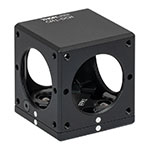 |
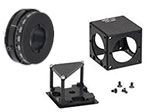 |
| Rectangular Dichroic Mirrors and Filters | Empty Compact 30 mm Cage Cube |
| Posted Comments: | |
user
(posted 2017-06-14 19:25:59.073) I understand the prism is epoxied to the mount, but can the two parts of the mount still be separated? I would like the prism (with one half of the mount) to be removable from my optical setup. tfrisch
(posted 2017-06-26 04:09:50.0) Hello, thank you for contacting Thorlabs. The cage on top of the base can be removed by removing the 4 screws along the bottom of the cage. This would mean the setup would have to be attached to the cage and the base could drop out if you do not post mount the base. Please reach out to TechSupport@Thorlabs.com if you would like to discuss further. |

| Specifications | |||||
|---|---|---|---|---|---|
| Prism | |||||
| Surface Quality | 40-20 Scratch-Dig | ||||
| Surface Flatness | <λ/10 at 633 nm | ||||
| Angular Tolerances | ±1 arcmin | ||||
| Reflective Beam Angle | 90° ± 20 arcmina | ||||
| Reflective Coating | Aluminum with Inconel and Black Paint Overcoat |
||||
| Material | N-BK7b | ||||
| Dimensions | A = B = C = 20 mm L1 = L2 = 28.3 mm |
||||
| Dimensional Tolerance | ±0.1 mm | ||||
| Unmounted Prism Item # | PS932 | ||||
| Assembly | |||||
| Outer Dimensions | 1.50" x 1.50" x 1.50" (38.1 mm x 38.1 mm x 38.1 mm) |
||||
| Clear Aperture | >Ø12 mmc | ||||
| Cage Cube Material | Anodized Aluminum | ||||
| Mounting Hole | Imperial: 8-32 Tapped Hole Metric: M4 Tapped Hole |
||||
- 20 mm Penta Prism Mounted in a SM1-Compatible Cage Cube
- Deviate Beams without Reversal or Inversion of the Beam Profile
- 90º Beam Deviation is Insensitive to Beam/Prism Alignment
Thorlabs' Cube-Mounted Penta Prisms are constructed with a 20 mm
penta prism in a 30 mm cage cube with two closed sides to minimize light leakage. These penta prisms deviate incident light by 90° without inverting or reversing the image. Each prism is fabricated from N-BK7 with two aluminized reflective faces protected by an Inconel black paint overcoat. The mechanical housing for these optics limits the clear aperture to >Ø12.0 mm.
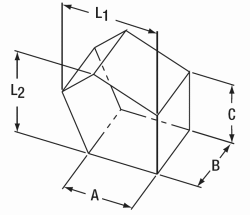
Figure G1.1 Prism Dimension Schematic

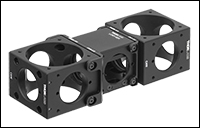
Click to Enlarge
Figure 437B A C4W and C6W Cage Cube connected to a 1.5" wide
CCM1-4ER Compact Cage Cube using the C4W-CC and CM1-CC Cube Connectors, respectively.
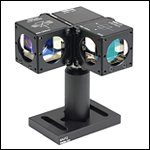
Click to Enlarge
Figure 437A CM1-CC Cage Cube Connector Connecting Multiple 1.5" Wide Cage Cubes
- Connect Two 1.5" Wide Cage Cubes Side by Side
- Connect a 1.5" Wide Cage Cube to a 2" Wide Cage Cube
- Compatible with CM1 or CCM1 Series Cage Cubes
The CM1-CC cage cube connector allows two or more CM1 or CCM1 style cubes to be connected as shown in Figure 437A. The CM1 and CCM1 series of cage cubes, which are all compatible with this connector, include empty cubes, empty dichroic cubes, mounted beamsplitters, mounted penta prisms, and mounted turning mirrors. The CM1-CC cage cube connector includes four 4-40 button-head screws, two 4-40 flat-head screws, four washers, and a 1/16" hex key.
Two cage cube-mounted turning mirrors cannot be connected using the CM1-CC due to a lack of Ø6 mm cage rod holes on two sides of the cube.
We also offer the C4W-CC to connect two 2" wide 30 mm cage cubes. Both C4W-CC and CM1-CC cage cube connectors can be used to connect one 1.5" wide 30 mm cage cube, such as our CCM1-4ER(/M), with a 2" wide 30 mm cage cube.
Alignment Pins
Please note that because dowel alignment pins are used, the connector requires drilled holes on the cube face between the SM1-threaded (1.035"-40) ports. If you have an older cube and would like it updated to have alignment holes for free, please contact Technical Support. Alternatively, the alignment pins are press-fit inside their mounting holes, and can be pressed out for use with cubes that do not have these alignment holes.
 Products Home
Products Home






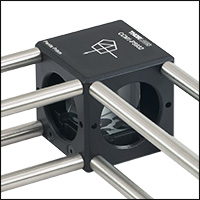

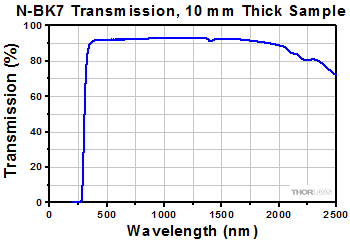
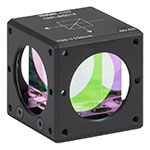
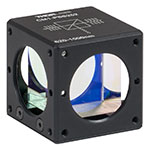
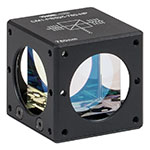
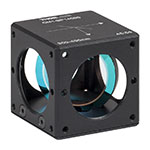
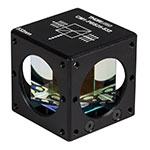
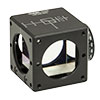
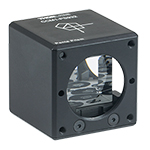
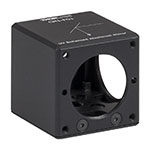
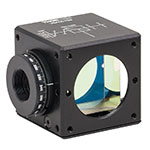
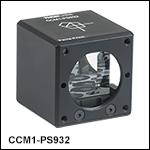
 Zoom
Zoom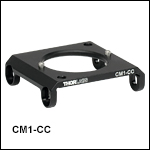
 Mounted Penta Prisms
Mounted Penta Prisms